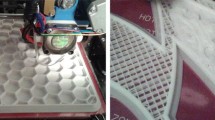Abstract
The goal of this research was the creation of an adaptation mechanism for the delivery of three-dimensional content. The adaptation of content, for various network and terminal capabilities – as well as for different user preferences, is a key feature that needs to be investigated. Current state-of-the art research of the adaptation shows promising results for specific tasks and limited types of content, but is still not well-suited for massive heterogeneous environments. In this research, we present a method for transmitting adapted three-dimensional content to multiple target devices. This paper presents some theoretical and practical methods for adapting three-dimensional content, which includes shapes and animation. We also discuss practical details of the integration of our methods into MPEG-21 and MPEG-4 architectures.
Similar content being viewed by others
References
Adelson, E.: Mechanisms for motion perception. Optics &Photonics News 2(8), 24–30 (1991)
Aggarwal, A., Regunatha, S., Rose, K.: Compander domain approach to scalable AAC. Proceedings 110-th Audio Engineering Society Convention (2001)
Ahn, J., Wohn, K.: Motion Level-of-Detail: A simplification method for crowd scene. Proceedings Computer Animation and Social Agents (CASA), pp. 129–137 (2004)
Amielh, M., Devillers, S.: Multimedia content adaptation with XML. Proceedings International Conference on Multimedia Modeling (MMM), pp. 127–145 (2001)
Amielh, M., Devillers, S.: Bitstream syntax description language: application of xml-schema to multimedia content adaptation. Proceedings 11-th International WWW Conference: CDROM (2002)
Berka, R.: Reduction of Computations in physics-based animation using level of detail. Spring Conference on Computer Graphics, pp. 69–76. Comenius University (1997)
Carlson, D., Hodgins, J.: Simulation of levels of detail for real-time animation. Proc. Graphics Interface, pp. 1–8. ACM (1997)
Chen, B., Nishita, T.: Multiresolution streaming mesh with shape preserving and QoS-like controlling. Proceedings 3D Web Technology, pp. 35–42. ACM (2002)
Cohen, J., Varshney, A., Manocha, D., Turk, G., Weber, H., Agarwal P., Brooks, F., Wright, W.: Simplification envelopes. Proceedings ACM SIGGRAPH, pp. 119–128 (1996)
Cohen, J., Olano, M., Manocha, D.: Appearance preserving simplification. Proceedings ACM SIGGRAPH, pp. 115–112 (1998)
Debunne, G., Desburn, M., Cani, M., Barr, A.: Dynamic real-time deformations using space and time adaptive sampling. Proceedings ACM SIGGRAPH, pp. 31–36 (2001)
DeHaemer, M., Zyda, M.: Simplification of objects rendered by polygonal approximations. Comput. Graphics 15(2), 175–184 (1991)
Di Giacomo, T., Capo, S., Faure, F.: An interactive forest. Proceedings Eurographics Workshop on Computer Animation and Simulation, pp. 65–74 (2001)
Di Giacomo, T., Joslin, C., Garchery, S., Magnenat-Thalmann, N.: Adaptation of virtual human animation and representation for MPEG. Comput. Graphics 28(4), 65–74 (2004)
Distler, H., Gegenfurtner, K., VanVeen, H., Hawken, M.: Velocity constancy in a virtual reality environment. Perception 29(12), 1423–1435 (2000)
Eck, M., DeRose, T., Duchamp, T., Hoppe, H., Lounsbery, M., Stuetzle, W.: Multiresolution analysis of arbitrary meshes. Proceedings ACM SIGGRAPH, pp. 173–182 (1995)
Fogel, E., Cohen-Or, D., Ironi, D., Zvi, T.: A web architecture for progressive delivery of 3d content. Proceedings 3D Web Technology, pp. 35–41. ACM (2001)
Funkhouser, T., Sequin, C.: Adaptive display algorithms for interactive frame rates during visualization of complex virtual environments. Proceedings ACM SIGGRAPH, pp. 247–254 (1993)
Garland, M., Heckbert, P.: Simplifying surfaces with color and texture using quadric error metrics. Proc. IEEE Visualization, pp. 263–270 (1998)
Giang, T., Mooney, R., Peters, C., O’Sullivan, C.: ALOHA: adaptive level of detail for human animation towards a new framework. Proceedings Eurographics, pp. 71–77 (2000)
Granieri, J., Crabtree, J., Badler, N.: Production and playback of human figure motion for visual simulation. ACM Trans. on Modeling and Computer Simulation 5(3), 222–241 (1995)
Heckbert, P., Garland, M.: Multiresolution modeling for fast rendering. Proceedings Graphics Interface, pp. 43–50 (1994)
Heckbert, P., Rossignac, J., Hoppe, H., Schroeder, W., Soucy, M., Varsney, A.: Multiresolution surface modeling course. ACM SIGGRAPH, Course 25 (1997)
Hoeting, J., Madigan, D., Raftery, A., Volinsky, C.: Bayesian model averaging: a tutorial. Statist. Sci. 14(4), 382–417 (1999)
Hoppe, H.: Progressive meshes. Proceedings ACM SIGGRAPH, pp. 99–108 (1996)
Hoppe, H.: View-dependent refinement of progressive meshes. Proceedings ACM SIGGRAPH, pp. 189–198 (1997)
Hoppe, H., DeRose, T., Duchamp, T., McDonald, J., Stuetzle, W.: Mesh optimization. Proceedings ACM SIGGRAPH, pp. 19–26 (1993)
Hutchinson, D., Preston, M., Hewitt, T.: Adaptive refinement for mass/spring simulations. Proc. EUROGRAPHICS Workshop on Computer Animation and Simulation, pp. 31–45 (1996)
Joslin, C., Magnenat-Thalmann, N.: MPEG-4 animation clustering for networked virtual environments. IEEE Conference on Multimedia and Expo (ICME): CDROM (2004)
Kourtzi, Z., Shiffrar, M.: Dynamic representations of human body movement. Perception 28(1), 49–62 (1999)
Lindstrom, P., Turk, G.: Image-driven mesh optimization. ACM Trans. on Graph. 19(3), 204–241 (2000)
Multimedia Framework (MPEG-21) Part 7: Digital Item Adaptation; ISO/IEC JTC 1/SC 29/WG 11/FDIS 21000-7:2004
Ohshima, T., Yamamoto, H., Tamura, H.: Gaze-directed adaptive rendering for interacting with virtual space. Proceedings Virtual Reality Annual International Symposium (VRAIS), pp. 103–110. IEEE Computer Society (1996)
Ponder, M., Papagiannakis, G., Molet, T., Magnenat-Thalmann, N., Thalmann, D.: VHD++ development framework: towards extendible, component based vr/ar simulation engine featuring advanced virtual character technologies. Proceedings Computer Graphics International (CGI), pp. 96–104. IEEE Computer Society (2003)
Soucy, M., Laurendeau, D.: Multiresolution surface modeling based on hierarchical triangulation. Comput. Vision Image Understand. 63(1), 1–14 (1996)
SPECViewPerf 7.1.1: http://www.spec.org/gpc/opc.static/viewperf71info.html
Author information
Authors and Affiliations
Corresponding author
Rights and permissions
About this article
Cite this article
Kim, H., Joslin, C., Di Giacomo, T. et al. Device-based decision-making for adaptation of three-dimensional content. Visual Comput 22, 332–345 (2006). https://doi.org/10.1007/s00371-006-0009-3
Published:
Issue Date:
DOI: https://doi.org/10.1007/s00371-006-0009-3




